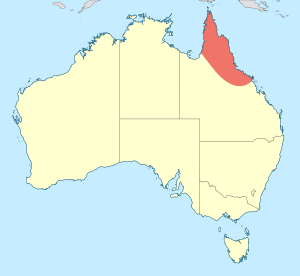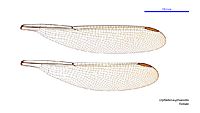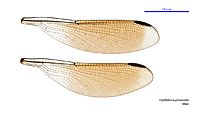Tropical rockmaster facts for kids
Quick facts for kids Tropical rockmaster |
|
|---|---|
 |
|
| Tropical rockmaster at Cairns, Australia | |
 |
|
| Female at Atherton Tableland, Australia | |
| Conservation status | |
| Scientific classification | |
 |
|
| Synonyms | |
|
Diphlebia reinholdi Forster, 1910 |
The tropical rockmaster (scientific name: Diphlebia euphoeoides) is a type of damselfly found in Australia. It is also sometimes called Diphlebia euphaeoides. This damselfly has wide wings.
It belongs to a group known as the azure damselflies. You can find it in Queensland, Australia, and also in Papua New Guinea. These damselflies usually live near lakes, waterfalls, or streams. They prefer places that are not too high up. Sometimes, you might even see them near pools that have dried up.
What Makes It Special?
The tropical rockmaster is quite large for a damselfly. When it rests, its wings are spread out wide. People sometimes confuse it with dragonflies. However, damselflies are usually not as strong-looking as dragonflies. Also, a damselfly's eyes do not touch in the middle, unlike most dragonflies.
Appearance
Male tropical rockmasters are very striking. They have bright blue and black bodies. Their wings are dark. You can tell them apart from a similar damselfly, the sapphire rockmaster (Diphlebia coerulescens). The blue marks on the male tropical rockmaster's body are smaller. Its belly is mostly black.
Its wings are the widest among damselflies in its group. The back wings are even wider than the front wings. Its legs are a brownish-black color.
Female tropical rockmasters look different from the males. They are mostly brown and yellow-green. Their wings are also smoky-colored.
Life Cycle
The tropical rockmaster goes through an incomplete metamorphosis to become an adult. This means it changes from an egg to a nymph, and then to an adult. It does not have a pupa stage like butterflies. Both the adult and the nymph are predators, meaning they hunt other small creatures.
Female damselflies lay their eggs underwater. They often lay them on moss and reeds around November. The young damselfly, called a nymph, lives underwater for about one year. Adult damselflies usually appear in September and October. This species is not very common, but it is not considered to be in danger.
Discovery
The tropical rockmaster was first described in 1907. A young English scientist named Robin Tillyard studied insects. He collected the first example of this damselfly in January 1905. He found it at Mervyn Creek in Queensland.
Later, in 1910, another scientist named Forster collected what turned out to be the same species. He found it near Port Moresby in New Guinea. He named it Diphlebia reinholdi.
Gallery




